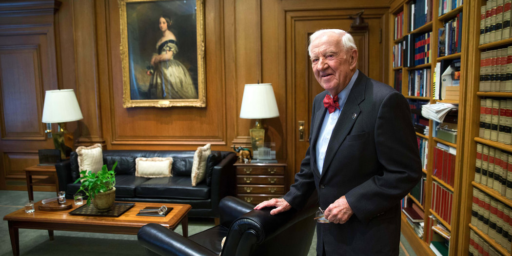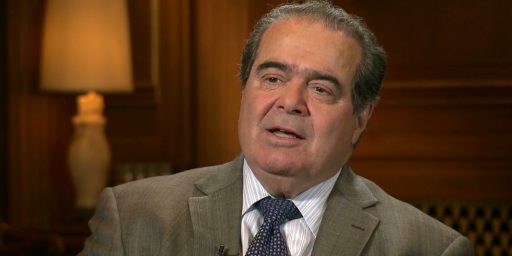Supreme Court Adjusting Nicely to Chief Justice Roberts
Linda Greenhouse reports that the Supreme Court is a much happier place now that the burden of an ailing Chief Justice has been lifted. She also offers some anecdotal evidence of the collegiality of the group that belies the public perception that it is divided into warring ideological camps.
Advice to the Chief Justice: To You, I’m Known as Nino (NYT)
At the end of the first week of the Supreme Court’s new term, the justices assembled to discuss the week’s cases, and, following protocol, Chief Justice John G. Roberts Jr. stated his own views first. Then, in keeping with the court’s tradition for the justices-only conference, the new chief called on the others, one by one. He did so in order of seniority, referring to his colleagues in the most formal terms. First, “Justice Stevens,” followed by “Justice O’Connor” and then “Justice Scalia.” Justice Antonin Scalia interrupted. “I will always call you Chief,” he said. “But to you, I’m Nino, and this is Sandra, and this is John.”
This vignette, described by Justice Clarence Thomas at a judicial conference in Colorado Springs late last month, is deliciously revealing of a Supreme Court in the midst of a generational shift.
John Roberts was a 25-year-old law clerk and John Paul Stevens was beginning his fifth year as a Supreme Court justice when the two first met. In the 25 years that followed, the younger man became a familiar figure to the justices as he appeared before them dozens of times, building a reputation as one of the most skilled and sought-after Supreme Court practitioners. But by their very nature, these courtroom meetings were not meetings of equals. Now when John Roberts joins the other justices on the bench or around their conference table, he is not only their equal, but first among them.
Although Chief Justice Roberts has appeared at ease in the courtroom from the moment he took his seat on the first Monday in October, the transition can only have been dizzying. Just months ago, he was a court of appeals judge who took the subway to work. Now he is called for each morning and delivered home at night in a Supreme Court car.
By his choice, it is an ordinary car, a sport utility vehicle, in contrast to the limousine used by his predecessor, Chief Justice William H. Rehnquist. The limousine has gone the way of the four gold stripes that the “old chief,” as the late chief justice is now almost universally referred to within the court, had added to each sleeve of his judicial robe. Still, the car and driver is a perquisite enjoyed by none of the other justices, who drive themselves to work in their own cars.
I’m glad to see that the stripes are gone. Rehnquist added them in a somewhat self-deprecating gesture. It came across, though, as rather pompous.
Ann Althouse has a dissenting opinion on the stripes.





Who knows, just maybe the SCOTUS will finally start being for “The poeple” for a change and not continue to be the “legislature” as they have been.
If Linda Greenhouse bothered to read a book, she might check out Chief Justice Rehnquist’s own book on the history of the court, or others. There is no perception within knowledgeable circles that the court is this warring group of factions behind the scenes. That is a perception that persists based on the frame of media reporting about the court.